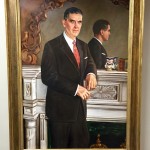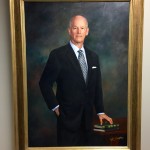Durham, N.C– On Monday April 27th at 6:30 pm a celebration of the 5 Chiefs of Staff took place. As many of you know, Orthopaedics became a department a little more than three years ago, previously being a division in the department of surgery. While part of surgery, we’ve had five chiefs of the division Alfred Shands, Lenox Baker, J. Leonard Goldner, James Urbaniak, and James Nunley. To celebrate our past leaders, we’ve commissioned portraits of each of these chiefs and will unveil them at an event held at the Doris Duke Centre in the Duke Gardens on the date above. Faculty, alumni, former staff and more attended this celebratory event.
Alfred Shands, Jr: Establishing the division
The division of orthopaedics was established in the department of surgery in 1930. Deryl Hart was chair of the department of surgery, and Alfred Shands, Jr was appointed the inaugural division chief. He established a separate clinical division, and started a residency training program. Dr. Shands left Duke for the DuPont Hospital in Delaware, and also went on to play a critical role founding the orthopaedic research and education foundation. Donors with the highest level of giving to the orthopaedic research and education foundation become members of the Shands circle.
Lenox Baker: Formalizing residency training
The second orthopaedic surgeon appointed at Duke was Lenox Baker, who became division chief after Alfred Shands departed Duke. He recruited additional faculty, and in 1944 formed the Duke Orthopaedic and Affiliated Institutions Training Program. This was a formal education program with a full-time director, defined goals, and an organized teaching and clinical experience. He was a supporter of children’s orthopedics, and the Lenox Baker hospital on duke’s campus is named for him. He integrated the care of Duke sports teams into orthopedics. After his retirement, he became active in the State Health Department and became the Secretary of the State Department of Human Resources.
J Leonard Goldner: Expanding in size and expertise
In 1967, J Leonard Goldner became chief. He expanded the size and scope of the residency and the division. During his tenure, formal research was incorporated into the division, and the division increased the areas of clinical expertise to include all areas of orthopedics. The residency was expanded to eight residents a year. He led by example, and promoted perfection in surgical technique across multiple disciplines, as well as exceptional doctor patient interactions.
James Urbaniak: Orthopaedic Innovations
James Urbaniak became chief in1984. During his tenure, he promoted the development of innovation in orthopaedic surgery. Duke became the pioneering center in replantation and microvascular reconstruction of injured extremities due to his work. Fellowships in multiple specialties in orthopaedics were established. The division’s international reach was strengthened, as new clinical and research links from around the world were developed.
James Nunley: Becoming a department
In 2002 James Nunley became chief of the division, and worked towards establishing orthopaedic surgery as a separate department. He worked to expand the division into the community and developed an independent alone orthopaedic clinic. His work culminated in the division becoming a department in 2011.





